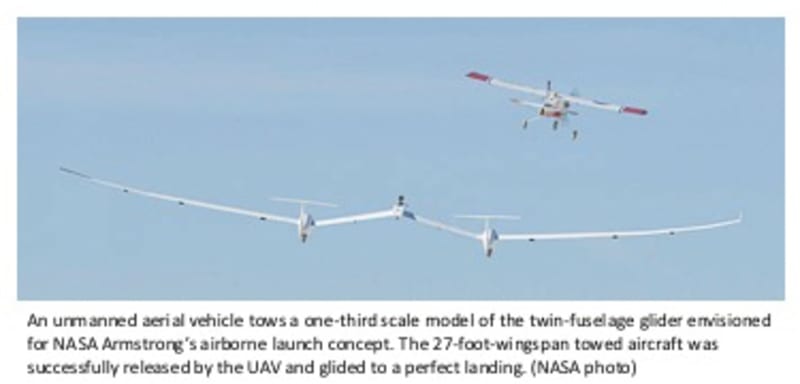Researchers at NASA’s Armstrong Flight Research Center have developed a new approach for putting satellites and other payloads into space that will revolutionize the commercial launch services market. Capitalizing on the advantages achieved by releasing payloads in midair rather than launching them from the ground, this unique approach uses a towed glider to put satellites into orbit efficiently, safely, and cost effectively.
The Problem:
Putting a satellite into orbit requires a lot of energy. Ground-launched rockets expend two-thirds of their propellant just to get through Earth’s atmosphere. Air-based launch is an option, but until now these methods have involved either (a) directly carrying the rocket underneath a modified airplane or (b) towing a wing-modified rocket behind an airplane. Despite their advantages, these air-launch methods face significant drawbacks related to expensive modifications and maintenance of the carrier aircraft, launch vehicle size limitations, and risks to aircrew.
The Solution:
Using a conventional airplane as the lead aircraft, NASA’s innovative approach involves towing an inexpensive, reusable, remotely piloted glider that is carrying a launch vehicle on its underside. Once the proper altitude (~40,000 feet) and speed are achieved, the glider is released from the airplane, which returns to the ground. The glider then uses its own rocket motor to increase its climb angle while maintaining airspeed until it releases the launch vehicle from a near-vertical attitude. The glider then returns to land at its base, while the launch vehicle continues on to space.
Its Advantages:
*Reduced Costs
Launch costs are significantly reduced by air launch, avoiding traditional launch range infrastructure and range operations constraints. It also avoids the costs of maintaining and operating launch pads.
*Increased Payload Weight
With NASA’s new approach, payloads to orbit can be 30 to 70 percent greater in mass than those launched via equivalent vehicles using existing air- and ground-based techniques, respectively.
*Expanded Launch Window
NASA’s launch method avoids the weather-related delays and launch-window restrictions associated with ground-based launches.
*Increased Flexibility
A wide variety of launch vehicles with varying geometries can be carried/deployed. Also, ground processing of multiple launch vehicles/payloads can be conducted in parallel, eliminating the cost impacts due to cascading schedule delays inherent in serial processing multiple launch missions from the same launch pad.
*Improved Safety
NASA’s technique eliminates the risk to personnel of having an on-board aircrew in an aircraft attached/close to a potentially explosive rocket.
*Reduced Development Costs/Risk and Increased Reliability
The Towed Glider method uses existing airframes rather than having to develop and test new rocket designs and/or glider attachments.
NASA’s technology can be used to place small satellites into low Earth orbit for a host of potential applications:
*Weather monitoring/forecasting
*Environmental/Climate monitoring
*Communications (e.g., telephone service, business/finance, telemedicine)
*Hazard/Disaster applications (e.g., forest fires, oil spills, search-and-rescue operations)
*Broadcast signals
*Navigation (e.g., Global Positioning System [GPS])
*Earth science research
*Space weather research
*Astrobiology and astrophysics research
*Planetary research
Video
Like this entry?
-
About the Entrant
- Name:Jerry Budd
- Type of entry:individual
- Patent status:pending

